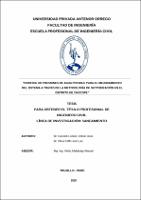Mostrar el registro sencillo del ítem
Control de presiones de agua potable para el mejoramiento del sistema a través de la metodología de sectorización en el distrito de Chocope
| dc.contributor.advisor | Vértiz Malabrigo, Manuel | |
| dc.contributor.author | Facundo Lozano, Edison Jesús | |
| dc.contributor.author | Oliva Caffo, José Luis | |
| dc.creator | Facundo Lozano, Edison Jesús | |
| dc.date.accessioned | 2020-09-14T21:59:41Z | |
| dc.date.available | 2020-09-14T21:59:41Z | |
| dc.date.issued | 2020 | |
| dc.identifier.uri | https://hdl.handle.net/20.500.12759/6553 | |
| dc.description.abstract | Actualmente a nivel mundial se esta viviendo con gran preocupación las consecuencias del cambio climático, teniendo como una de las principales problemáticas el tema de las aguas naturales, debido al consumo inadecuado y gastos innecesarios que se hacen del recurso; obignado de esta manera a todas las empresas prestadoras del servicio a tomar medidas eficientes y eficaces con respecto a la gestión del agua, donde un consumo adecuado del agua puede desempeñar un papel fundamental en el desarrollo de una política de aguas sostenible. El agua es un recurso renovable si es que su uso, tratamiento y circulación son el adecuado, de lo contrario se convierte en un recurso no renovable, siendo de por si, un recurso escaso, que debe ser controlado correctamente para evitar que se pierda, es por ello, que las empresas gestoras están en la obligación de disminuir el rango de pérdidas que se generan en los sistemas de abastecimiento, trayendo como consecuencia un aumento del rendimiento de la red y el agua sería mejor aprovechada por la población, al tiempo que generaría una mayor utilidad para la empresa gestora. Una de las soluciones adoptadas hoy en día por muchos gestores para mejorar la gestión y la eficiencia hídrica es la sectorización; que consiste básicamente en dividir la red en pequeños sectores, que permitan un mejor control de los caudales y las presiones. El objetivo principal de este proyecto es dejar plasmada una propuesta de sectorización que permita controlar las presiones de la red de agua potable del Distrito de Chocope, y así disminuir las fugas y por ende los rangos de agua no facturada. Para ello, se ha realizado un diagnóstico comercial y operacional que han permitido realizar la propuesta de sectorización. Después de la recaudación de datos y del análisis del estudio topográfico, se plasmó un modelo de sectorización teniendo en cuenta principalmente los desniveles que presenta el vi terreno, para poder considerar la presencia de válvulas rompe presión y válvulas de seccionamiento para un mejor control de los caudales y un mejor mantenimiento de las redes, sin afectar a otros sectores. “ | es_PE |
| dc.description.abstract | At the global level, the consequences of climate change are being lived with great concern, having as one of the main problems the issue of natural waters, due to inadequate consumption and unnecessary expenses that are made of the resource; obliged in this way to all the companies providing the service to take efficient and effective measures regarding water management, where adequate water consumption can play a fundamental role in the development of a sustainable water policy. Water is a renewable resource if its use, treatment and circulation are adequate, otherwise it becomes a non-renewable resource, being in itself a scarce resource, which must be properly controlled to prevent it from being lost, That is why, the management companies are obliged to reduce the range of losses that are generated in the supply systems, resulting in an increase in the performance of the network and water would be better used by the population, while It would generate greater utility for the management company. One of the solutions adopted today by many managers to improve water management and efficiency is sectorization; which basically consists of dividing the network into small sectors, which allows for better control of flows and pressures. The main objective of this project is to leave a sectorization proposal that allows to control the pressures of the drinking water network of the Chocope District, and thus reduce leaks and therefore the ranges of nonbilled water. For this, a commercial and operational diagnosis has been made that has allowed the sectorization proposal to be made. After the collection of data and the analysis of the topographic study, a sectorization model was created taking into account mainly the unevenness of the terrain, in order to consider the viii presence of pressure-breaking valves and sectioning valves for better control of the flows and better network maintenance, without affecting other sectors. | en_US |
| dc.description.uri | Tesis | es_PE |
| dc.format | application/pdf | es_PE |
| dc.language.iso | spa | es_PE |
| dc.publisher | Universidad Privada Antenor Orrego | es_PE |
| dc.relation.ispartofseries | T_ING.CIVIL_1850 | |
| dc.rights | info:eu-repo/semantics/openAccess | es_PE |
| dc.rights.uri | https://creativecommons.org/licenses/by/4.0/ | es_PE |
| dc.source | Universidad Privada Antenor Orrego | es_PE |
| dc.source | Repositorio Institucional - UPAO | es_PE |
| dc.subject | Agua Potable | es_PE |
| dc.subject | Presiones | es_PE |
| dc.title | Control de presiones de agua potable para el mejoramiento del sistema a través de la metodología de sectorización en el distrito de Chocope | es_PE |
| dc.type | info:eu-repo/semantics/bachelorThesis | es_PE |
| thesis.degree.level | Título Profesional | es_PE |
| thesis.degree.grantor | Universidad Privada Antenor Orrego. Facultad de Ingeniería | es_PE |
| thesis.degree.name | Ingeniero Civil | es_PE |
| thesis.degree.discipline | Ingeniería Civil | es_PE |
| dc.subject.ocde | https://purl.org/pe-repo/ocde/ford#2.01.00 | |
| renati.type | https://purl.org/pe-repo/renati/type#tesis | |
| renati.level | https://purl.org/pe-repo/renati/level#tituloProfesional | |
| dc.publisher.country | PE | es_PE |
Ficheros en el ítem
Este ítem aparece en la(s) siguiente(s) colección(es)
-
Ingeniería Civil [1260]


